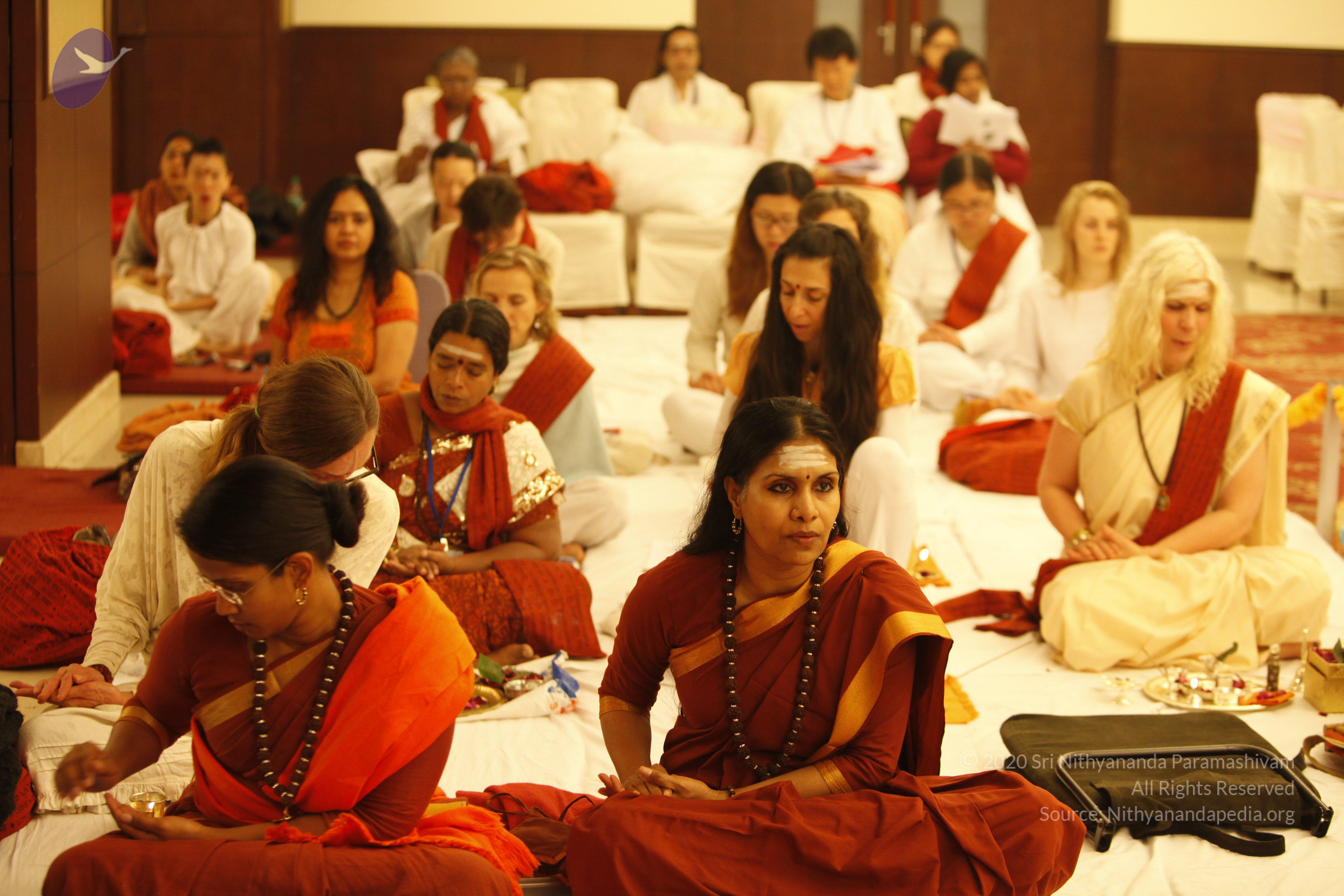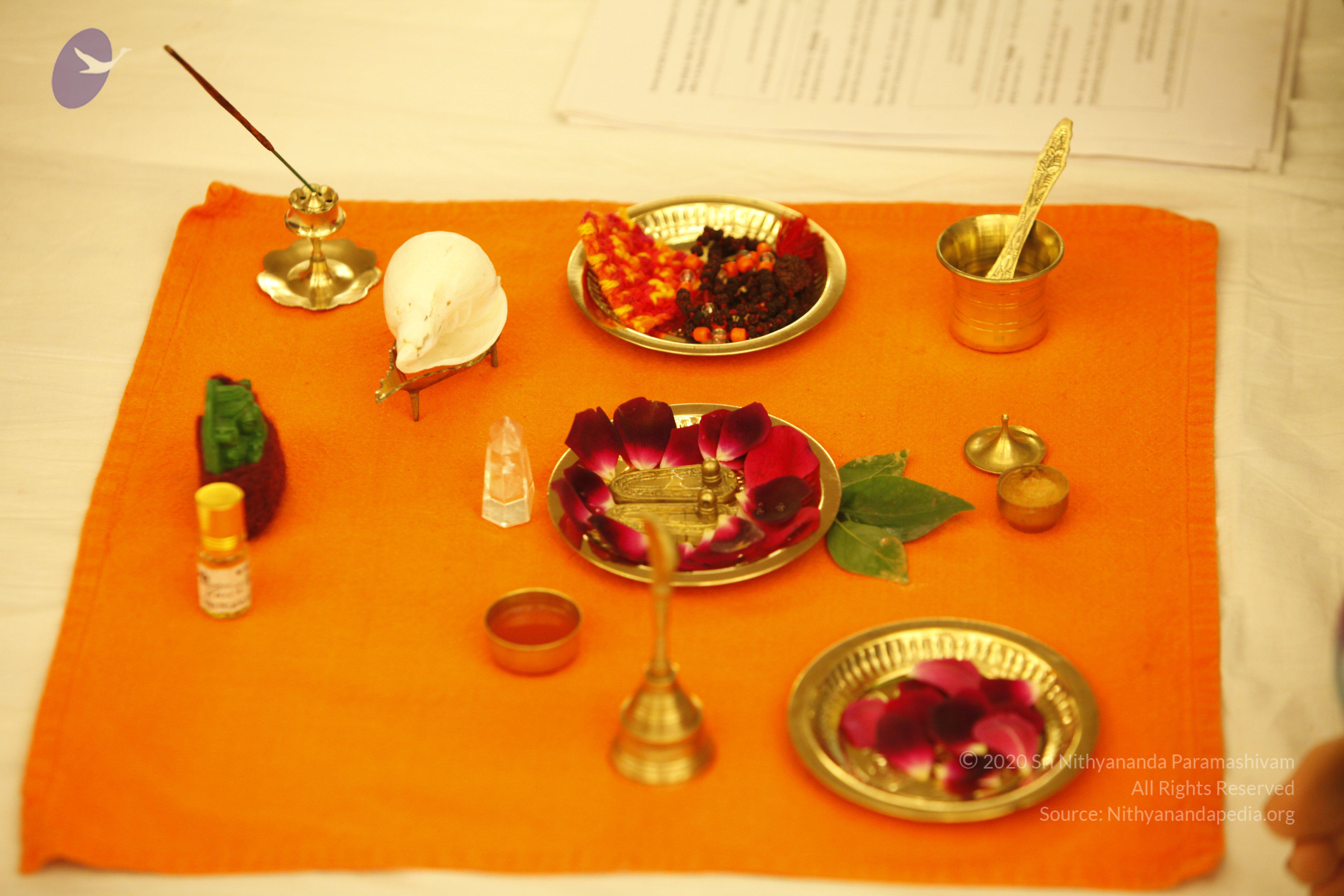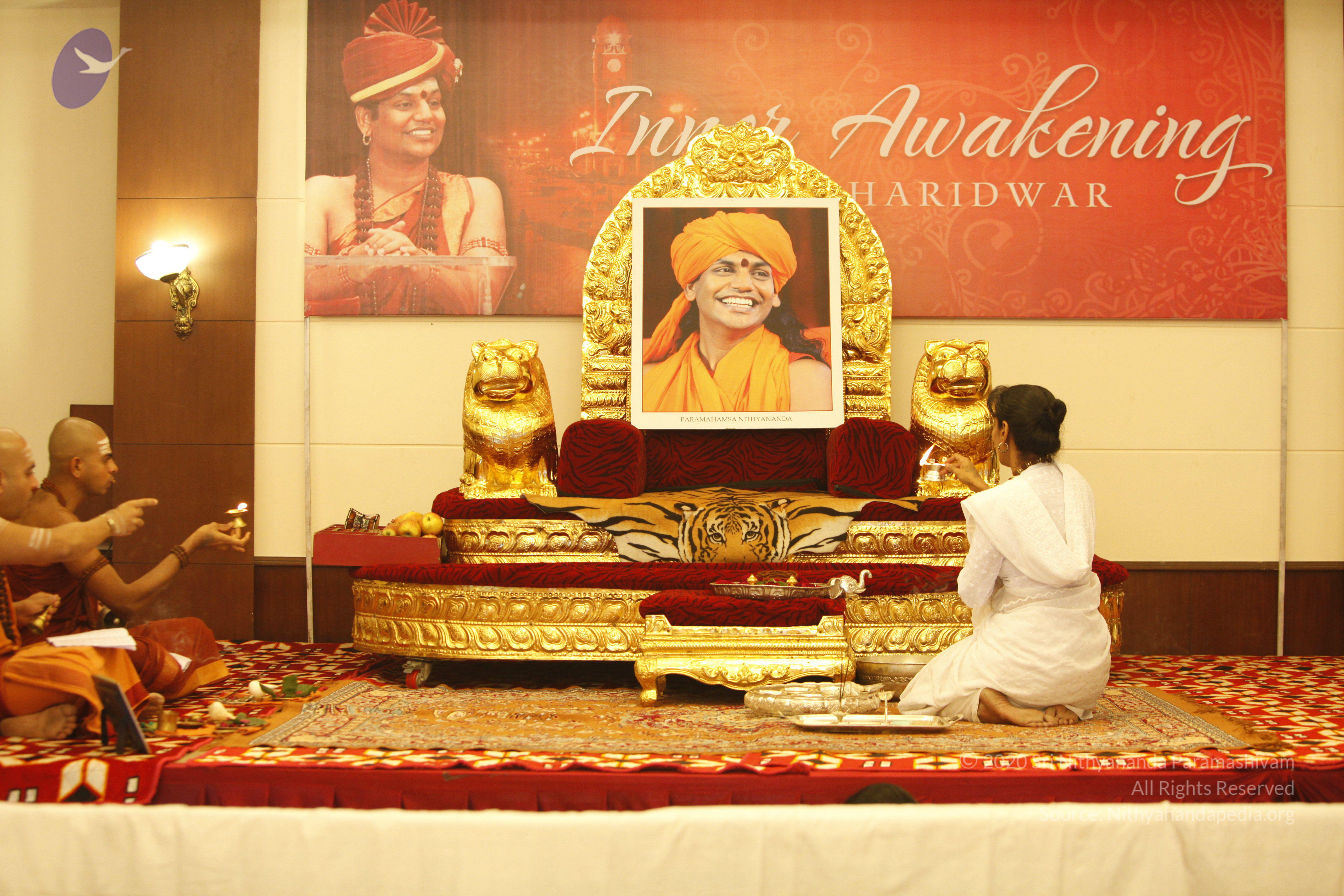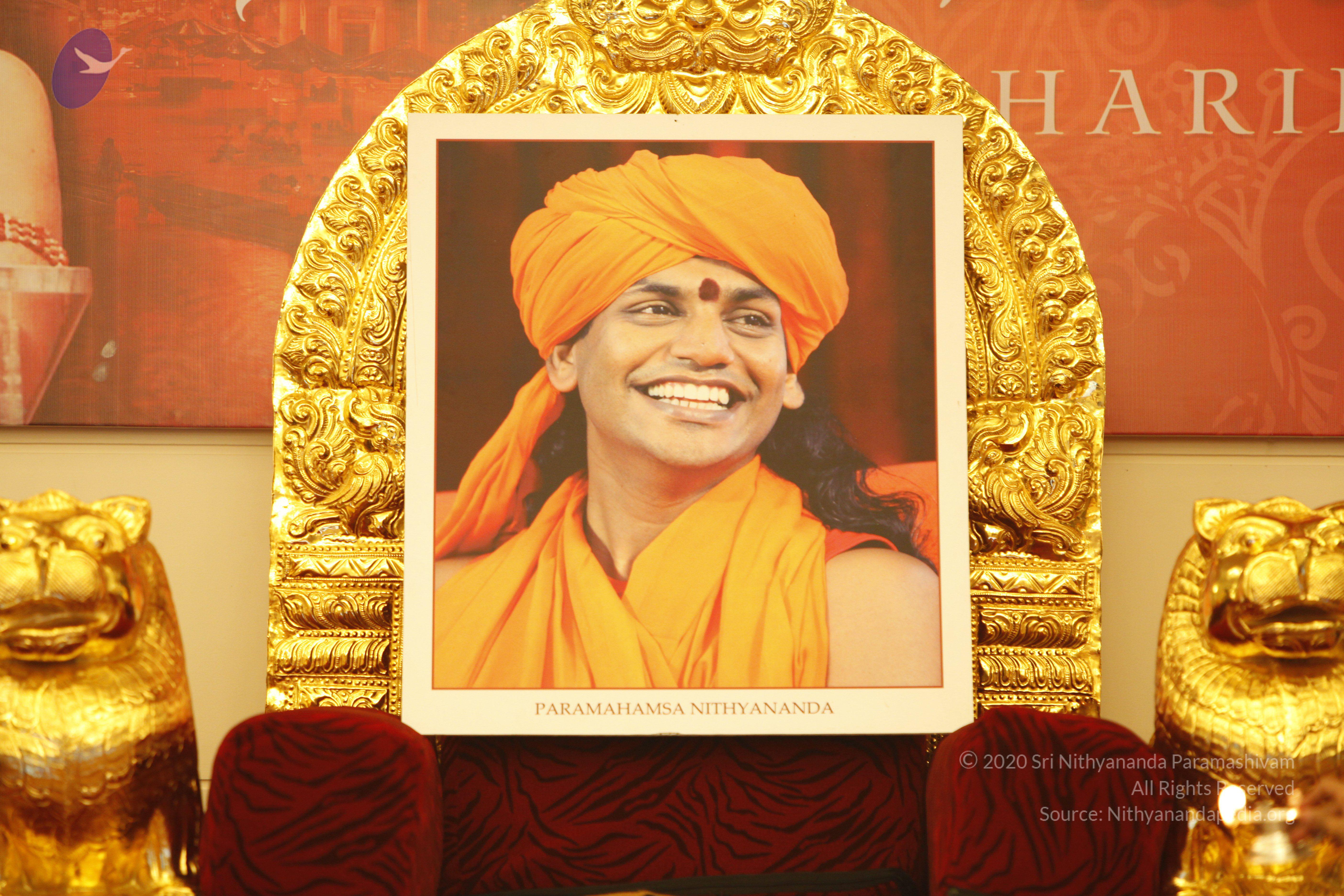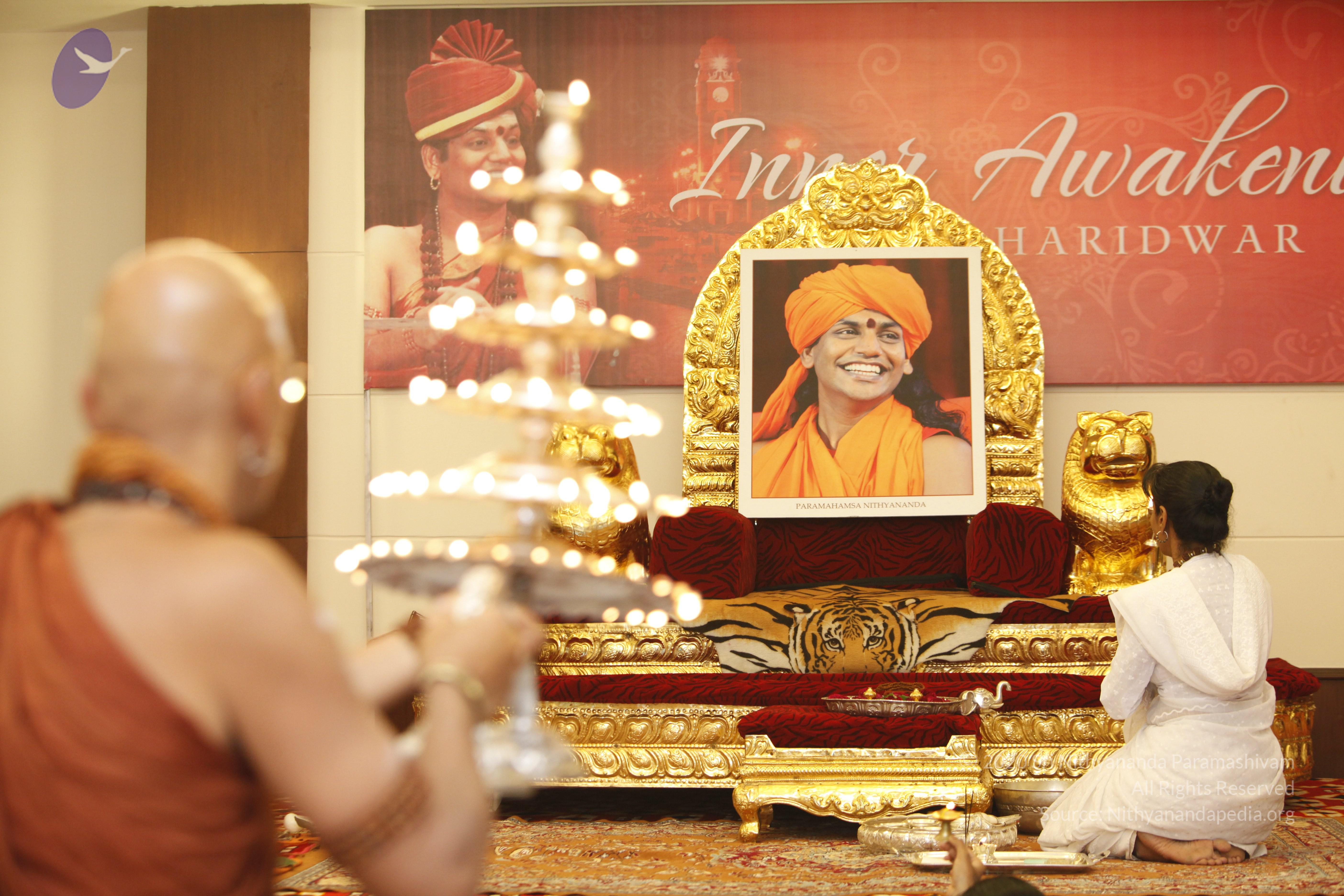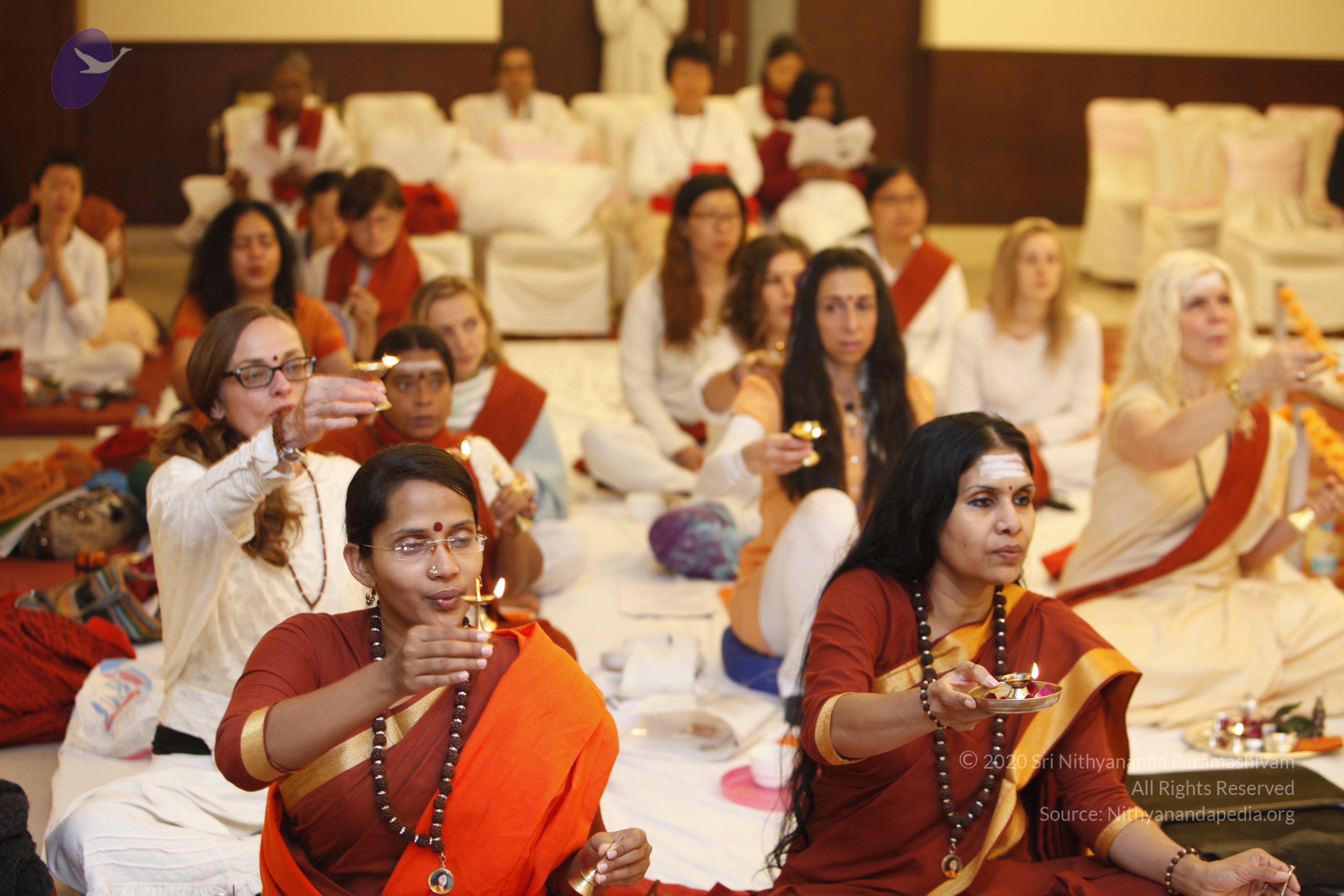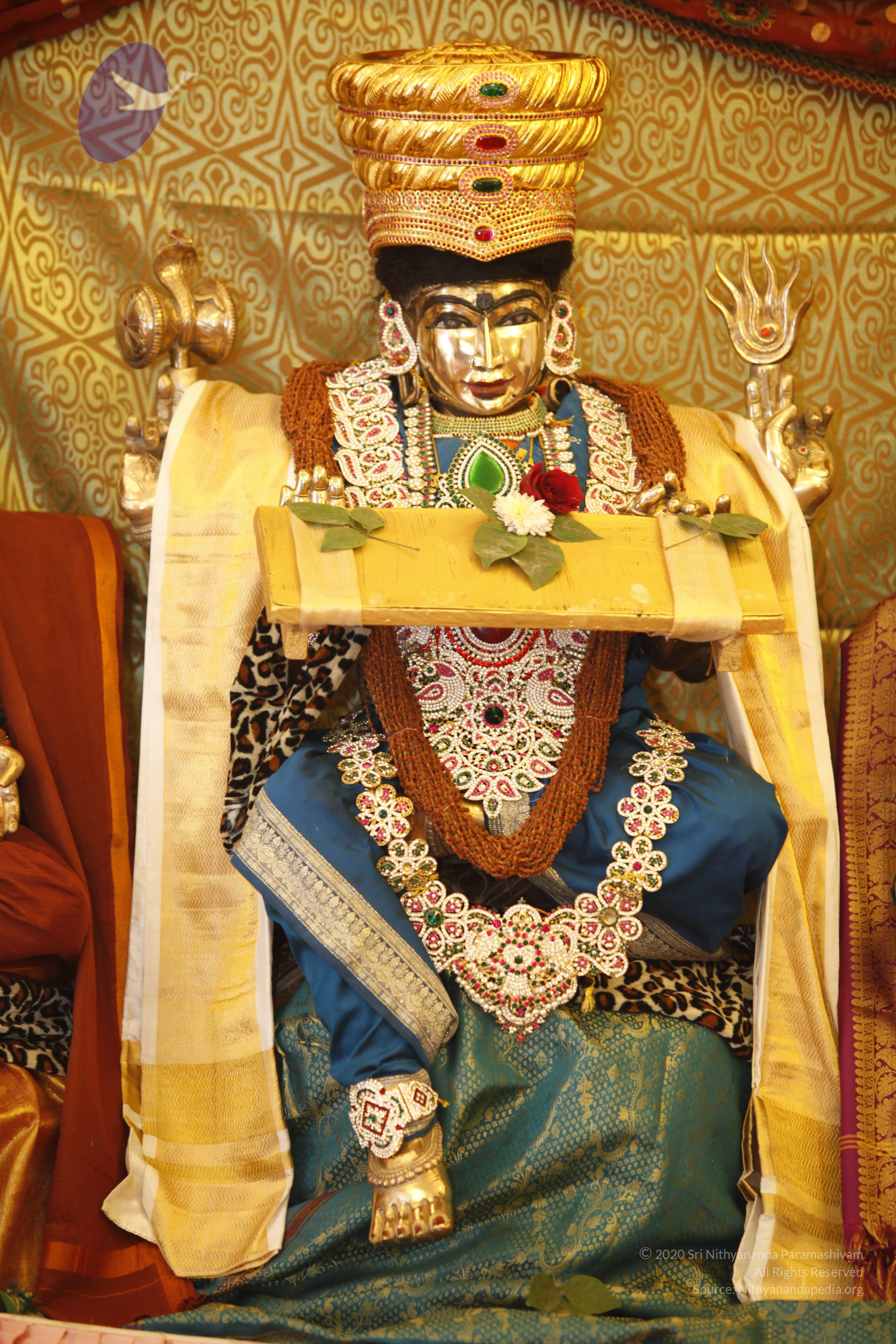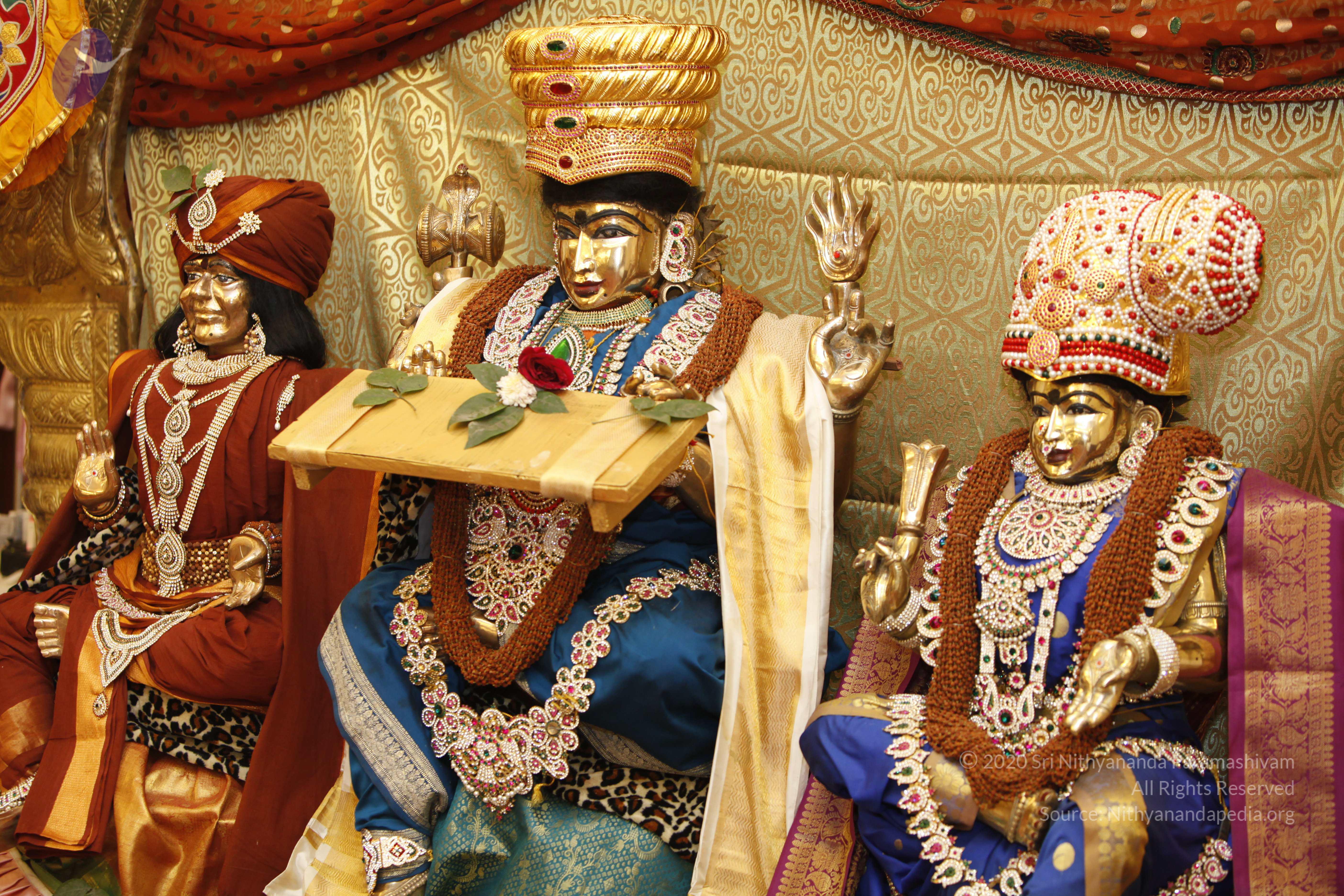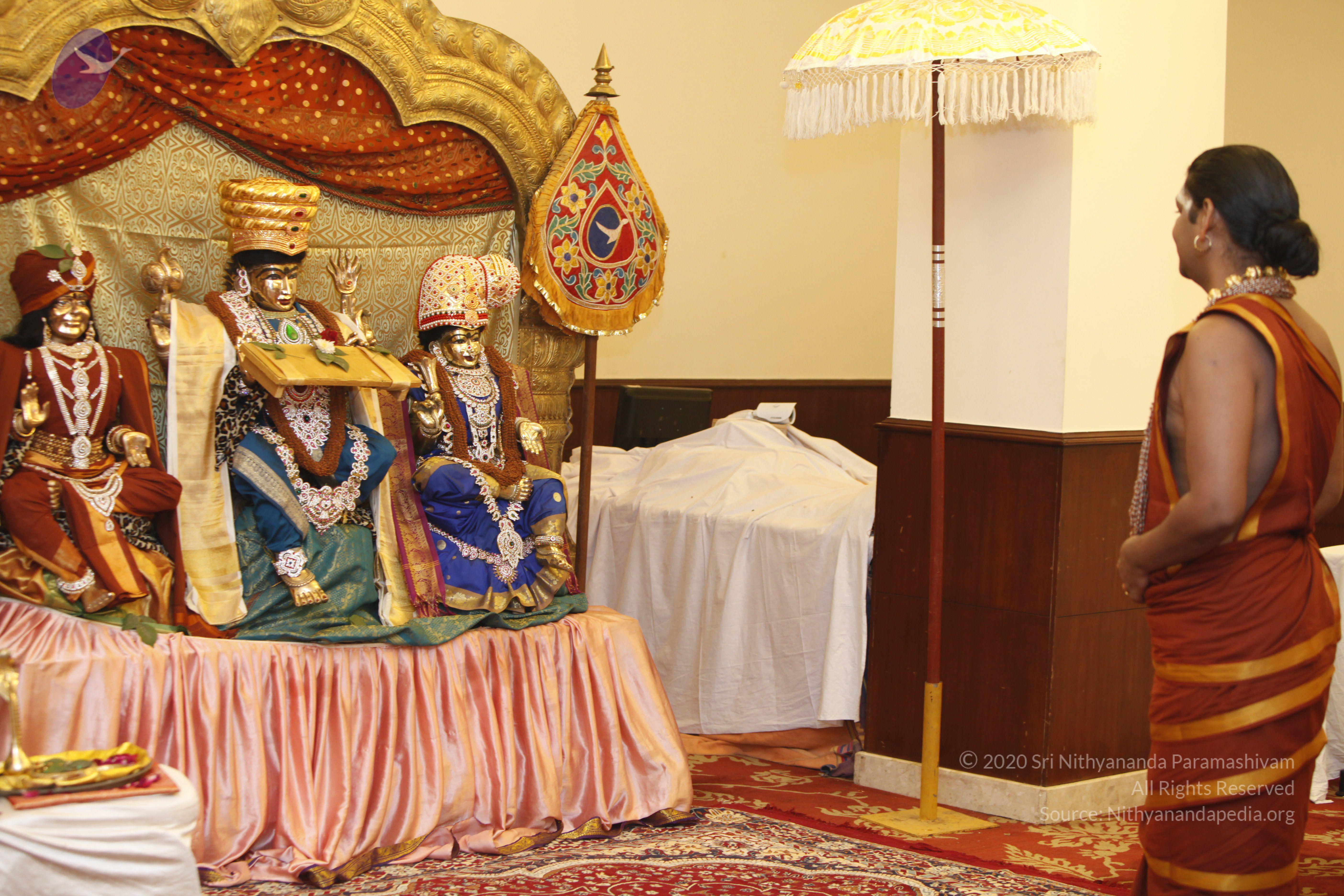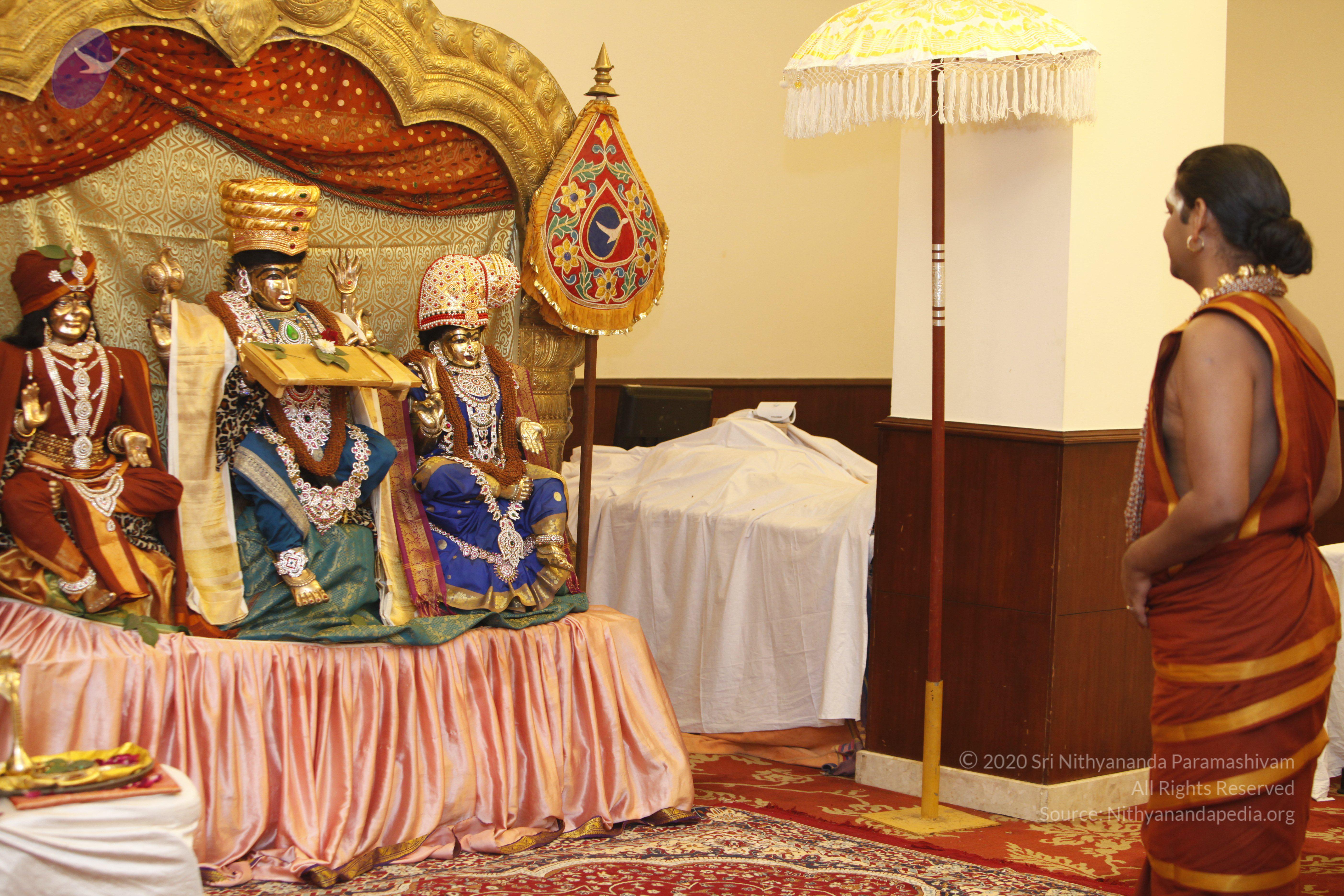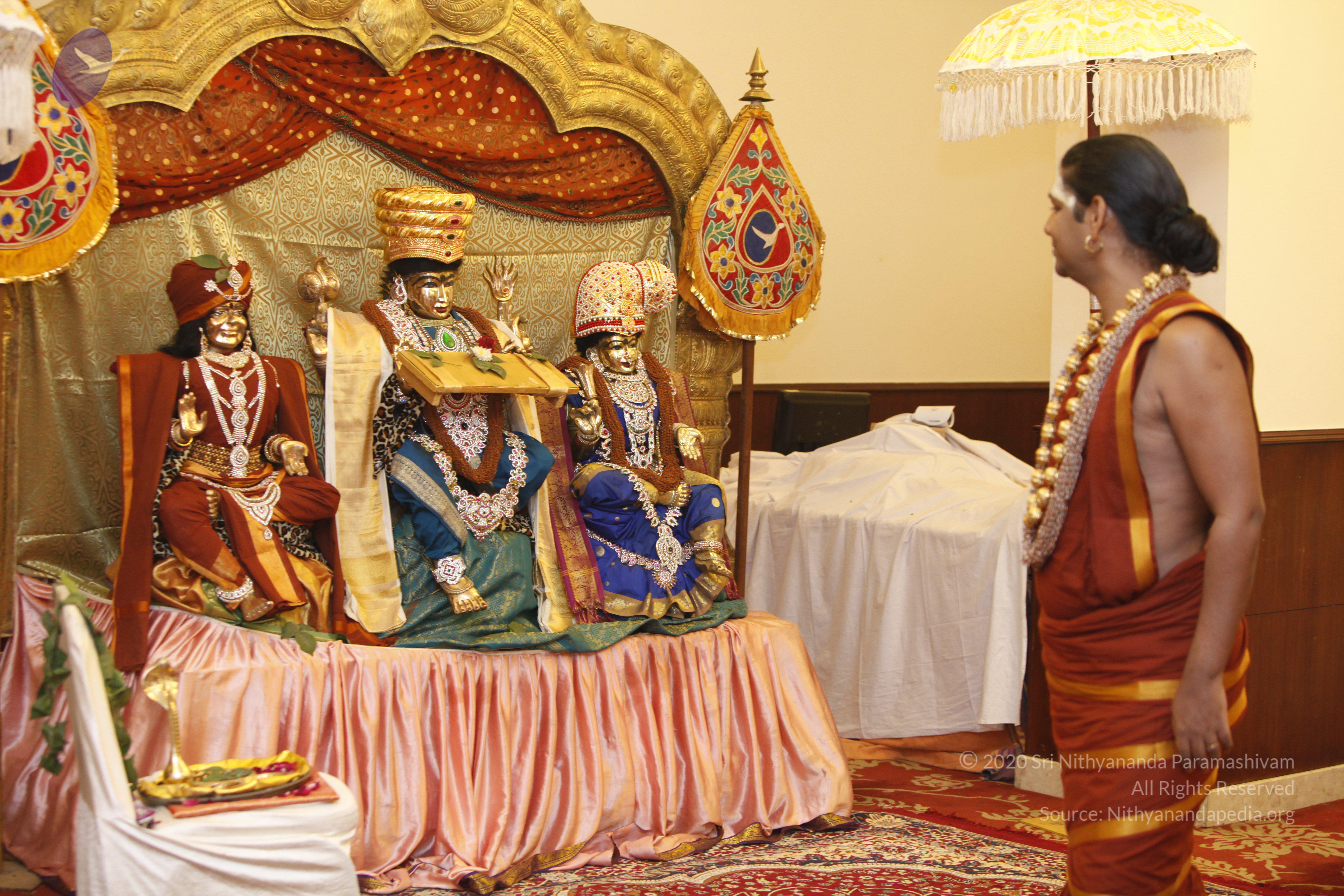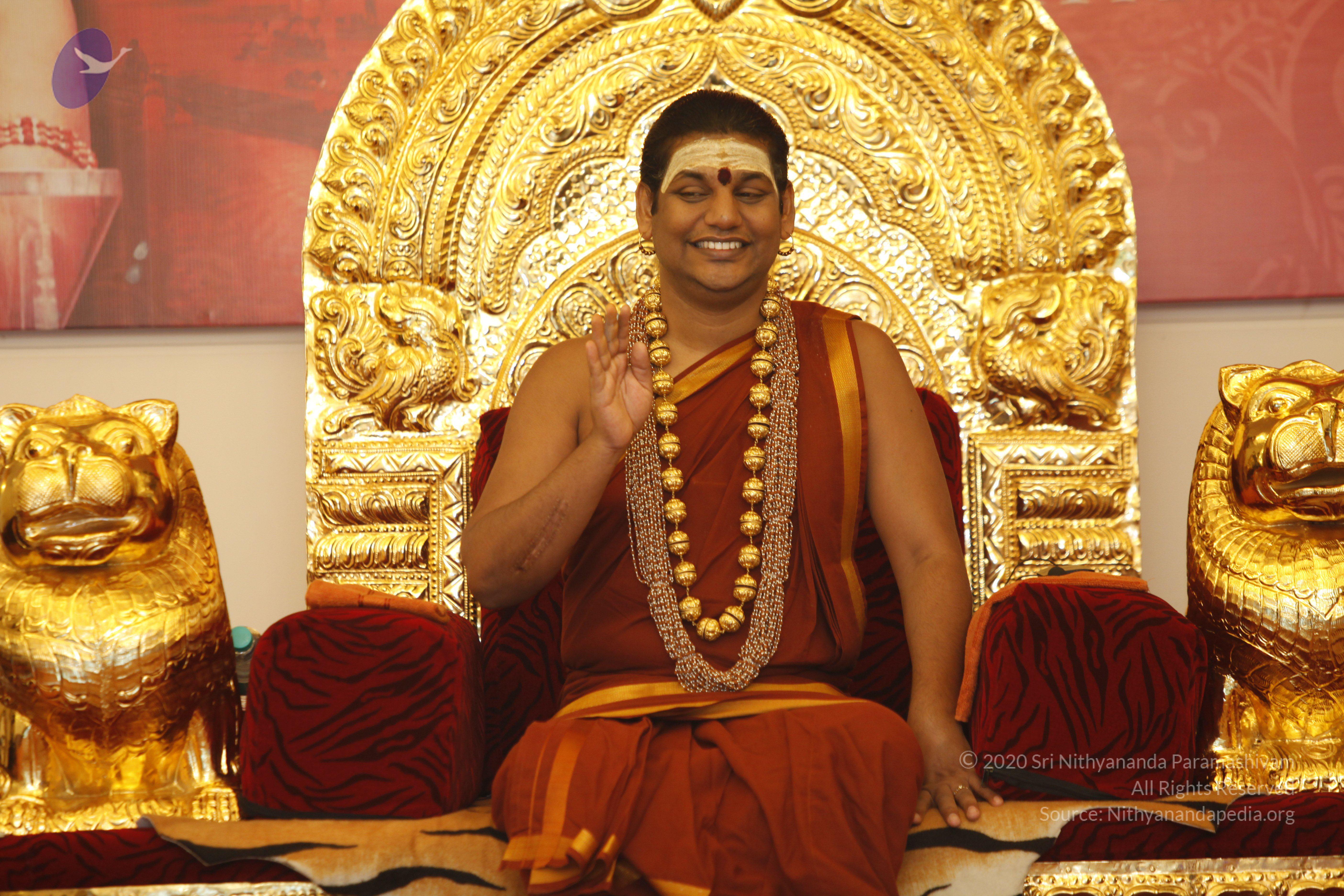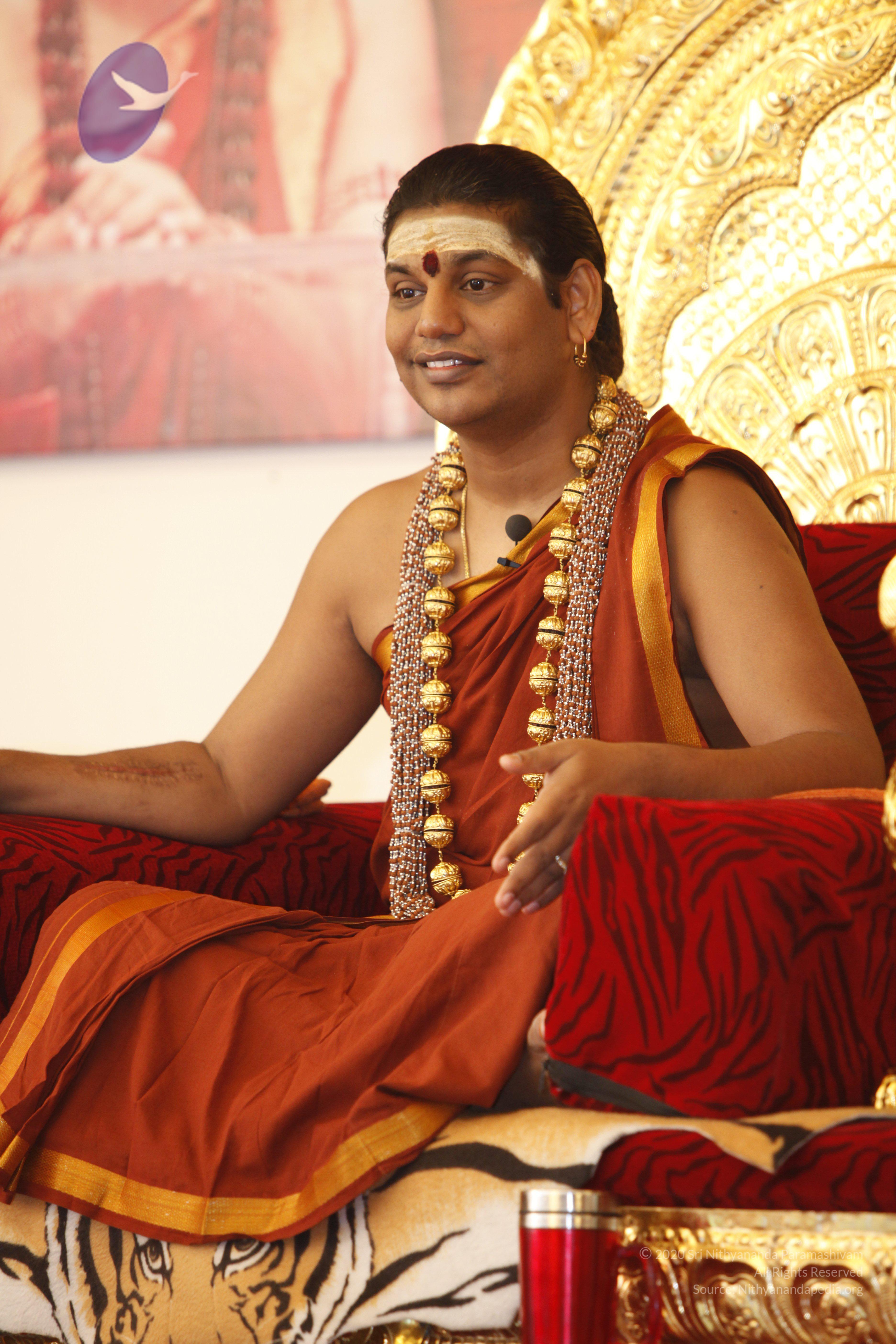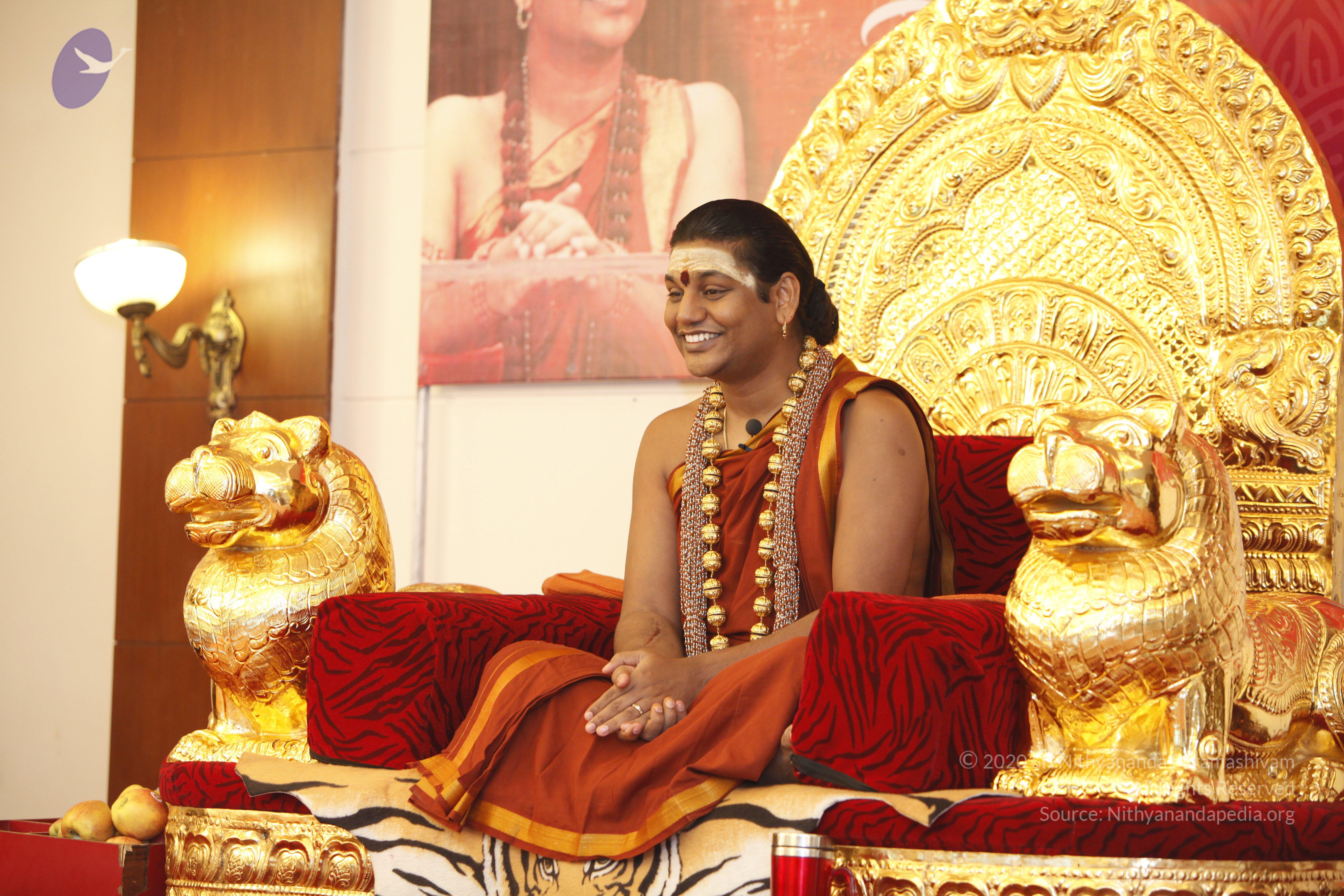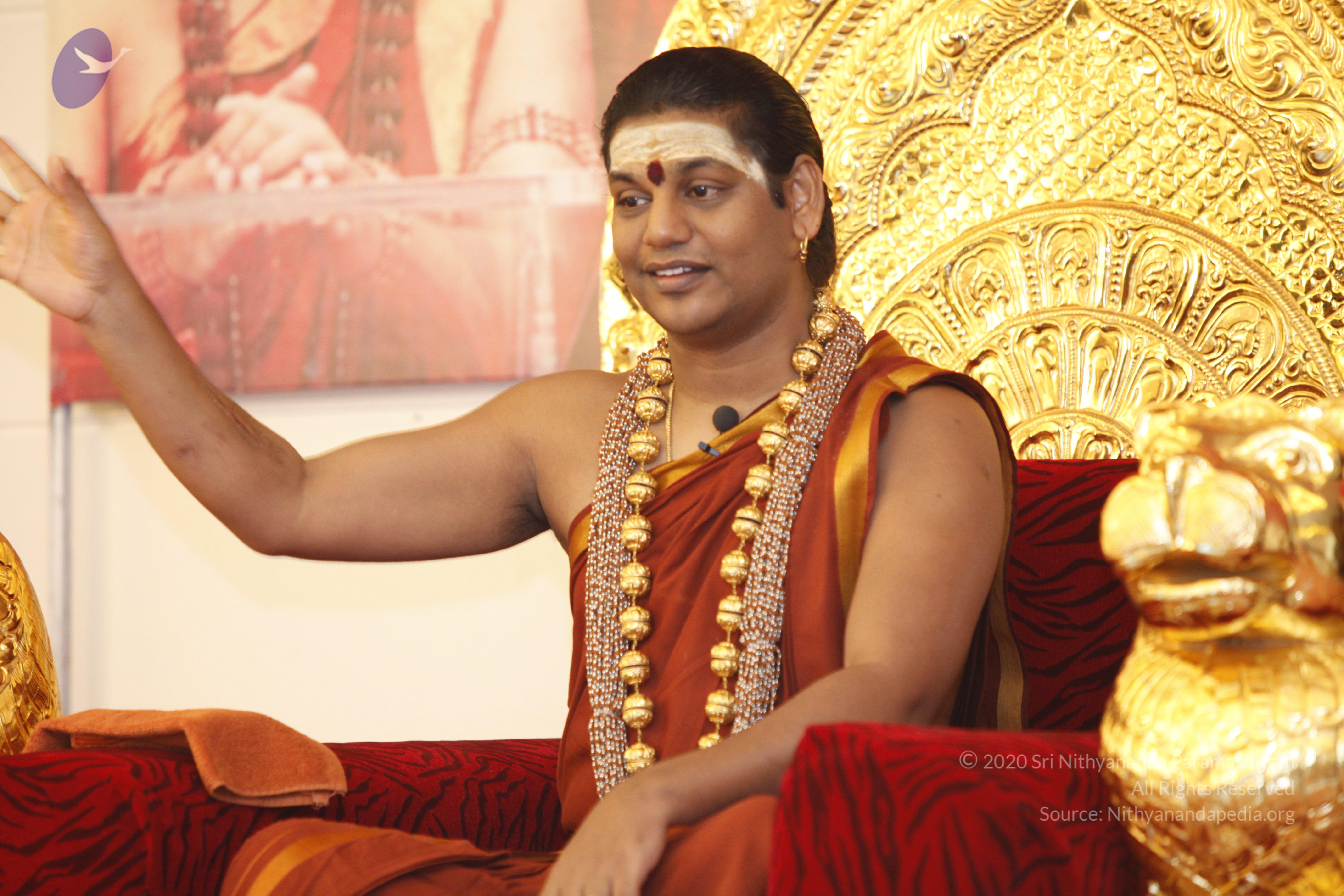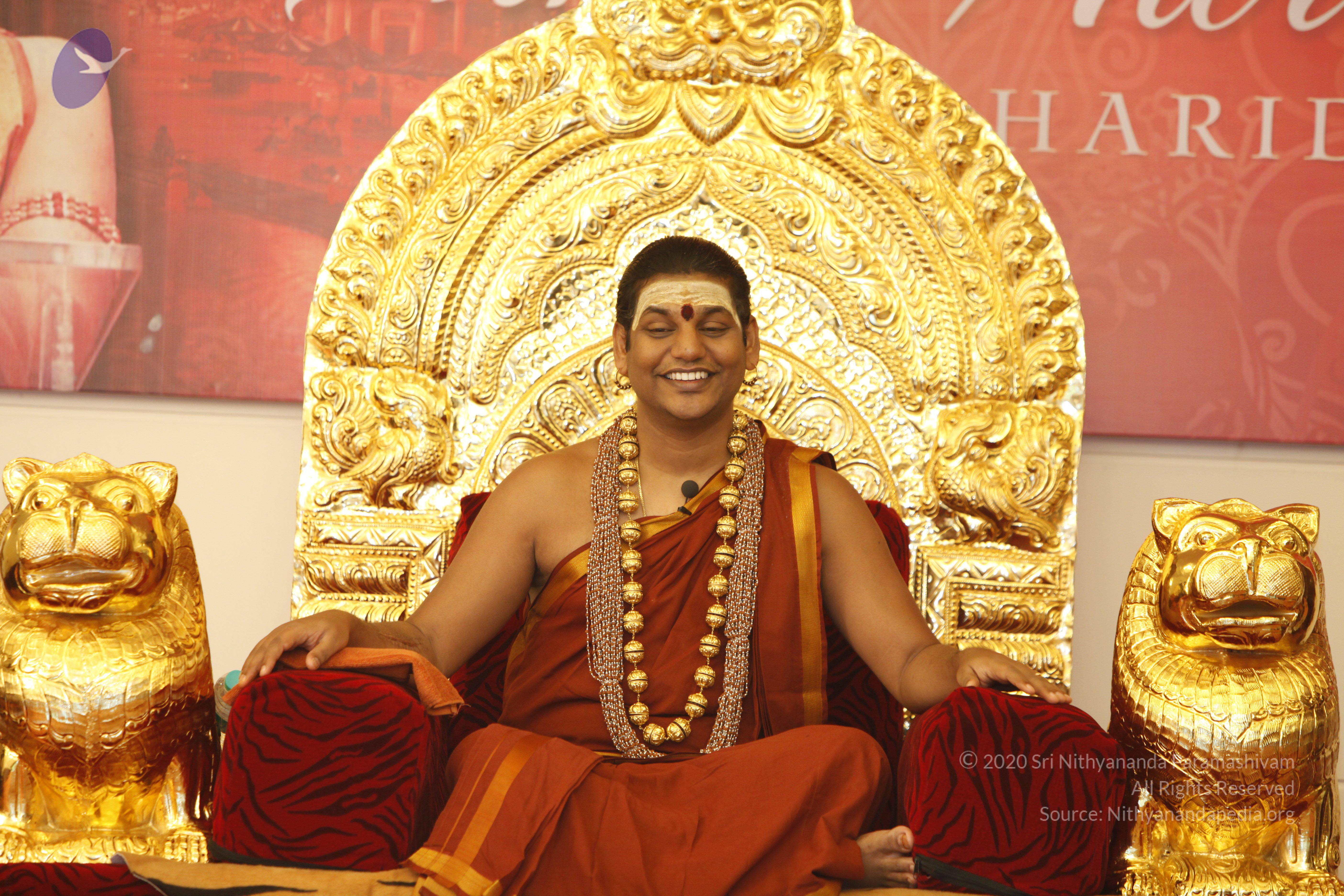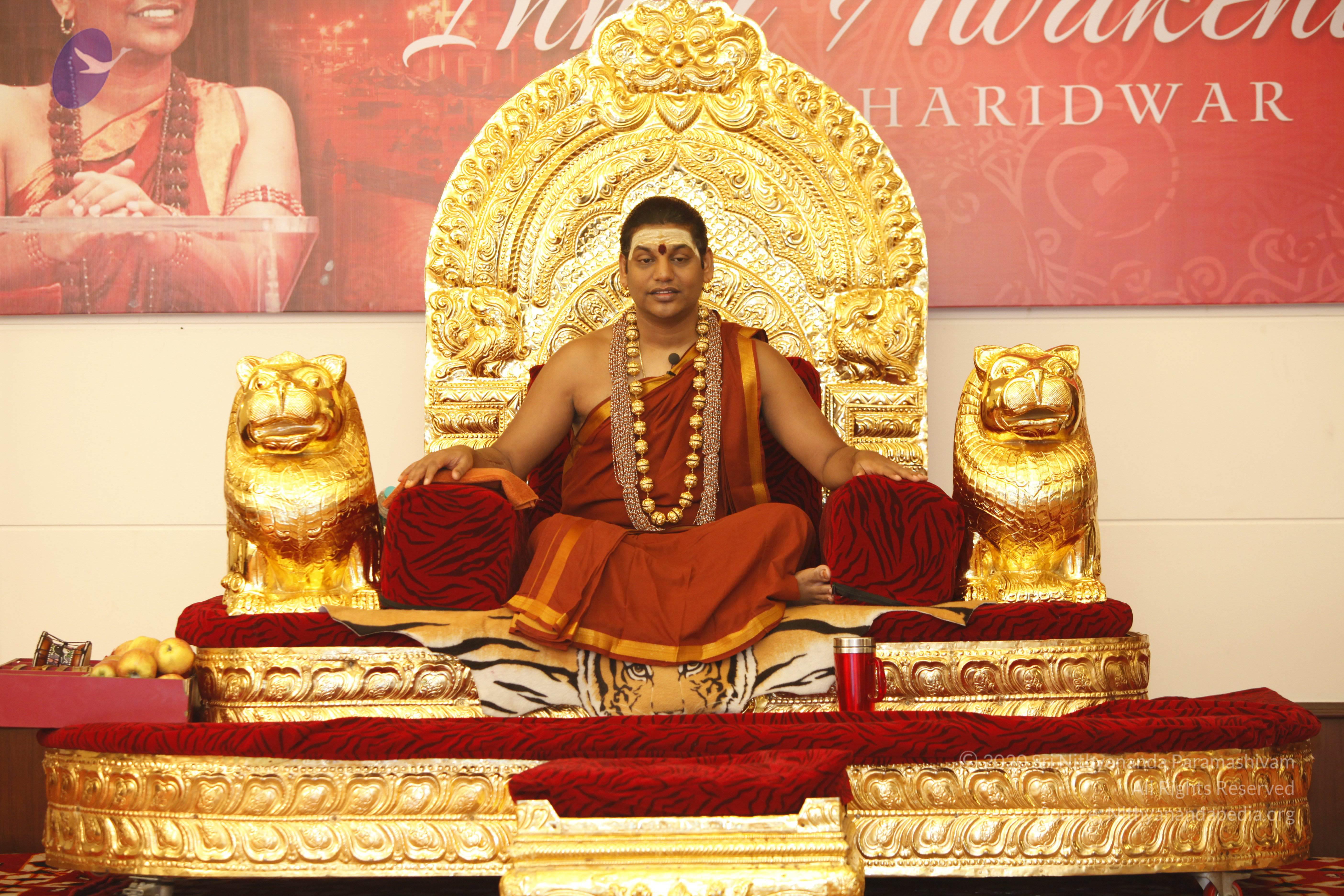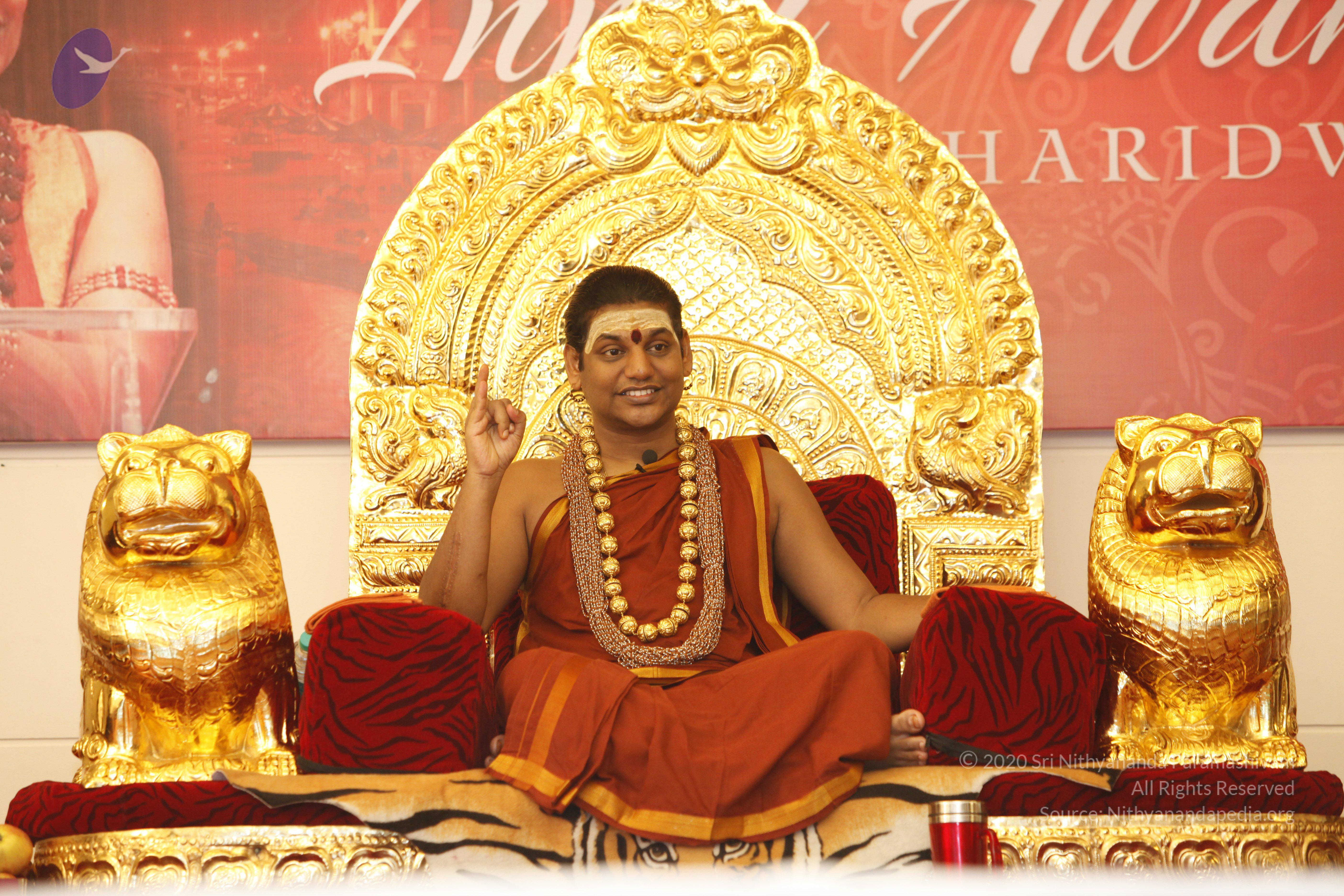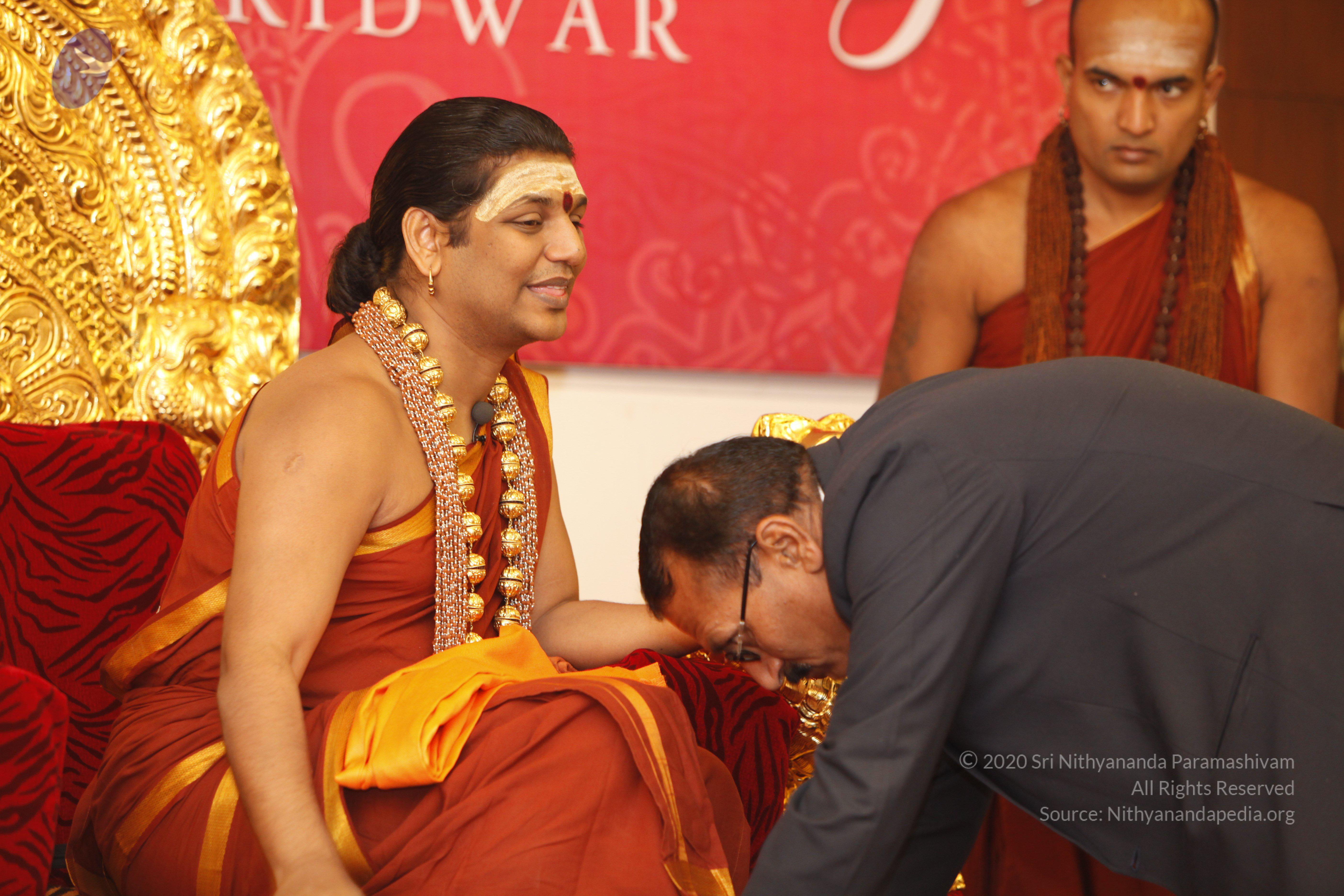January 17 2014
Title
Was Mahabharata A Dharmic War?
Description
Video and Audio - Was Mahabharata A Dharmic War?
In today’s morning Satsang, Paramahamsa Nithyananda advises us that in order to complete with SDHD, it is best to accept all of our various paradoxes and complexities. By hating any components of ourselves, we do not allow the transformation of those parts to happen. A potent way to learn how to handle the intricacies of our own personalities and of others is to study the Mahabharata. All the paradoxes and complexities of its characters can teach us how to understand not only our own components but how to handle life as it is!
| Video | Audio |
Transcript
Nithyanandeshwara Samaarambhaam Nithyanandeshwari Madhyamaam | Asmath Aachaarya Paryanthaam Vandhey Guru Paramparaam ||
(0:40)
I welcome all the Devotees, Disciples, Samajis, Satsanghis, everyone, visitors, viewers. I welcome every one of you with My love and blessings.
(1:10) Cities sitting with us in two-way video-conferencing - Houston-Kalahasti, Los Angeles-Arunachalam, Santa Fe-New Mexico, Toronto-Kailasam, Guadeloupe-Rameshwaram, Singapore-Singapuram, Oklahoma-Somanatham Nithyananda Nagaram-Hyderabad, Seattle-Chidambaram, Ohio-Prayag, Riverside-California, Dubai-Vaidyanatham, Austin, Hyderabad-Gupta Kashi, San Diego-La Jolla, Monterrey-Kedarnath, Hong Kong-Sirkazhi, Bogotá-Colombia, Klang-Malaysia, Oman-Sivagangai, Jorpati-Nepal, Kathmandu-Nepal, San Antonio-Texas, Coimbatore Dhyanapeetam, Hosur Dhyanapeetam and Kuala Lumpur-Palani. (2:14) The Kuala Lumpur-Palani center is today offering, ‘Anna Dhaan’ for one-lakh people. All our Sanyasis, Brahmacharis are working. You can all see the 100,000 people are given free food. The Nithyananda Hindu Sangha, Malaysia is distributing 100,000 food packets - you can see. In Kuala Lumpur, Batu Caves today is Thai Poosam Utsavam. Today is the day when Subramanya became Enlightened. Today is the same day he appeared on the Planet Earth and at the age of eight, Mahadeva gave him Enlightenment. And in the South, there is a tradition, on this same day Subramanya initiated Mahadeva at the age of twelve. In the South we make Subramanya so big he became, ‘Sivagurunathan’, he becomes Guru of Mahadeva.
(3:24) You see Mahadeva playfully asks, “Do you know the meaning of the Pranava - Omkara mantra?” Because, Subramanya arrests Brahma. See Subramanya asks Brahma, “Do you know the meaning of the Pranava?” Brahma was shaken. He said, “I only know the Mantra; I don’t know the meaning.” Then Subramanya arrests Brahma and says. “Then you are not qualified to be a Srishti Kartha. I will do your job.” Then the whole world is a mess. Mahadeva rushed to that place and asked him “Aye, why did you arrest Brahma? Release him.” He said, “No, he doesn’t know the meaning of the Pranava.” Then Mahadeva asked, “Do you know or what?” Then Subramanya says, “I know. If you want to know, be a disciple, I will teach you.”
(4:16) Then, the story says, Mahadeva sat politely as a disciple. Then Subramanya initiated him, gave him the meaning and Mahadeva was so happy to know from Subramanya; the story says, he changed ears. Subramanya was a kid; so he was carrying, when the Subramanya was teaching. Suddenly he changed from this side to this side. Then Subramanya asked, “Why do you change from right ears to left ear?” He said, “No let your mother also hear” - half is her’s na? So today is the day, Subramanya initiated Mahadeva into Pranava; and then Mahadeva says, “Even if you know the meaning of the Pranava, you don’t know the technology of Creation. You have to liberate him.” Then Brahma was released.
(5:11) So, all three festivals are observed today, mainly in three States – Andhra, Karnataka and Tamil Nadu – because only these three States has lot of Subramanya temples. Kukke Subramanya in Karnataka, and there is a big Subramanya temple in Andhra. Of course, Tamil Nadu is full of Subramanya temples and, all over the world, wherever the South Indians have settled, they created Subramanya temples. Everywhere the today is the celebration; especially in Tamil Nadu-Palani - I don’t know how many lakh will gather. In Arunachala also today is a very big festival celebrating Shivagurunatha Swami - means, who initiated Mahadeva himself. So, as per the tradition today, whoever comes to Subramanya, he initiates all of them, and blesses all of them - accepts all of them as disciples and followers.
(6:33) So, in Kuala Lumpur, Batu Caves, more than ten-lakh people – million people gather. Our Devotees have put a huge pandal you can see, tons and tons of food being cooked and packed and served. I think the way, the amount of food getting cooked and the number of volunteers working and the way it is being served; I think it’ll go more than 100,000 people. Please, you can see the whole team is our volunteer team, and the whole pandal is ours. On behalf of Dhyanapeetam, you can see, all our volunteers and you can see our banner – ‘Nithya Anna Daanam. Free Food for all. Thai Poosa Anna Dhaanam’. Great!
(7:40) My blessings to the whole Nithyananda Hindu Sangam, Malaysia, and the whole Malaysia itself. You guys are doing such wonderful job. All your past incompletions will be washed away. All your incompletions will be washed away. You will all be complete, blissful. All our Devotees, Disciples, Ashramites, Mahants, Kotharis, Thanedars, everyone in Malaysia; Devotees, everyone, blessings to all of you. All your past incompletions will be washed away. You will all be blissful, complete and let Subramanya’s grace be on all of you. This Batu Cave is a Siddha Peetha where Subramanya’s energy is so alive.
(8:38) My blessings. I am always happy when devotees are served. I want to do this job in India, in a large scale, like how Gayatri Peetha was doing yajnas. I really wanted some twenty-five lorry, full of items and people - they go to every big celebration, where Devotees gather; cook and feed. Like Iskcon is giving food. They say free food for education. I want to say free food for ‘spiritual yatras’. The ‘yatris’ - people who come to temple, should not suffer or should not be in want of anything. Whether it is a Magha Mela in Prayag, or Thai Poosam in Palani, or Deepam in Tiruvannamalai, or Meenakshi’s Marriage in Madurai, or Char Dham Yatra - we should be there giving food and serving devotees. (9:59) One of the Ramakrishna’s most beautiful biography – that book was called in Bengali ‘Sri Sri Ramakrishna Punthi’. In English they have translated, ‘Portrait of Sri Ramakrishna’. The book starts with a beautiful verse, ||Joyo Joyo Ramakrishno Bhojo Kolpotoru
Joyo Joyo Bhogoban Jogoter Guru| Joyo Joyo Ramakrishno Ishto GoshtiGon Shobhoye Chorono Renu Mage Ei Adhom||
It’s a Bengali verse. I revere and take respectfully, all the feet-dust of Ramakrishna’s Devotees. I tell you, this is the peak of Hinduism – being devoted to Devotees. ’Shobhoye Chorono Renu Mage Ei Adhom’.
(11:14) This whole book, I think around seven to eight-thousand verses I think - the whole book I know by heart. I used to read. Now that touch is lost. I forgot many things. It’s a beautiful book. By describing the beauty and glory of Devotees, the Master’s glory is described. I feel when you serve Bhaktas - Devotees - Bhagawan is more happy. Nithyananda Hindu Sangha, Malaysia, is doing that work. My blessings to all you guys. I am so happy. I would not have been happy, even if you had kept 1008 naivedyams in front of Me. But I am happy, you are now keeping hundred thousand naivedyams in front of My ‘Virat Swaroopa’ - the devotees in whom I am living.
(12:24) At one day I know, I will have thousands of my Sanyasis, Devotees, Kotharis, Mahants all over the world, serving the Devotees like this. We may not have enough resources now – people, money, organizing – to do this job. But I am really, really, really, at least I am putting it on record - my vision. When time comes, when world starts giving us more resources; I wanted this to be one of our top project, where at least ten-thousand Sanyasis do only this job. Anywhere the Yatra happens, go there with twenty-five lorry full of items; cook and feed million people, two-million people. This should be the... I think this is one of the best way, the tradition is kept alive.
(13:45) ‘Yatra’ – the spiritual tourism – is unique concept given by Hinduism to the world. All religions received this concept of Yatra - religious tourism, spiritual tourism - from Hinduism. Even now, India is the country where largest spiritual tourism happens in the world.
(14:17) I’ll continue to speak on Kalpataru and Mahabharata characters also. In between - few days - because we were having Mahabharata; I did not speak on Mahabharata. There was a live Mahabharat going on, ‘Aaj ka Mahabharat!’.
(14:38) But I tell you, never before, never after; this multi hero-heroine story was built. Understand. A human mind can conceive a story means - one hero, one heroine, one villain, one comedian, or maximum two hero, two heroine. But never, this large scale of multi hero-heroine-villain stories have been built.
(15:25) Look at Mahabharata. Who is the hero? - Yudhishtira? No. Arjuna? No. Pancha Pandavas, all the five? No, then what about Krishna? Alright, Pancha Pandavas and Krishna? No, what about Bhishma? Alright, Pancha Pandavas, Krishna and Bhishma. What about Karna? What way he is less heroic? Alright, Pancha Pandavas, Krishna and Karna, Bhishma. Then what about Drishtadhyumna? He is not heroic? What about Drona? Drona’s history can be a separate book. Yudhishtira’s can be separate book. Karna’s can be a separate book. The multiple hero, multi hero-heroine-villain story, which was never before or never after recorded so beautifully. I may not want to say, it is story ‘written’. I may only want to say, it is story ‘recorded’ - because, no human mind can conceive such a multiple layered stories.
(17:13) See, the modern-day very clearly proves - to conceive a multiple layered story, you need a subtle grooves of your brain awakened. When I read the story of Mahabharata, I am hundred-percent sure, Vyasa’s all subtle grooves of the brain have been awakened - all non-mechanical parts of the brain is awakened. I think Vyasa’s whole body was brain. Because, each character - Shikandini; he builds the Shikandi’s character for three birth and Shikandi is only one of the thousands of characters.
(18:14) Who will you call as a hero? Who will you call as a villain? Can you say Shakuni is the villain? No, then what about Duryodhana? Can you say Duryodhana is villain? Then what about Dusshasana, who has done more damage. If Dusshasana and Duryodhana and Shakuni are villain, then what about Dhritarashtra? If Duryodhana, Dusshasana, Dhritarashtra, if all of them are villain, what about Ashwatthama?
(18:51) Who is the heroine? Can you say Kunti is the heroine? Then what about Ganga? If you say Kunti and Ganga are heroine, then what about Gandhari? If Kunti and Ganga and Gandhari are heroine, then what about Draupadi?
(19:11) The multi-hero, multi-heroine, multi-villain story, which was neither conceived before, nor conceived after and nobody is made as hero; everything is recorded. Please understand. Nobody is shown as perfect. The fraudulence Krishna did - cheap fraudulences are recorded. Arey, Krishna comes to know that on Amavasya Day, if the war starts Duryodhana is going to win, and this fellow goes to the Ganga and starts giving ‘Tarpana’. The Sun and the Moon - Surya and Chandra - they get surprised and they look, “What is this? Why is Krishna giving Tarpana today? Today is not Amavasya.” They both run to him and ask, “O Mahadeva, Bhagawan, why are you giving Tarpana today? Today is not Amavasya.” Then Krishna looks at them and asks, “What is the meaning of the Amavasya?” They say, “When Sun and the Moon meet, both of us meet”. Krishna says, “I already made both you guys meet, Tarpana is done go - Amavasya!” What a silly game for a Bhagawan to play. What a silly game for a Bhagawan to play. But, I tell you, he is the greatest being. Krishna you can never compare.
(21:12) Never before nor after, a personality like Krishna happened, who can play all the games. He was neither integrated… Integrity - Krishna’s integrity, if I have to give the mark, I will give zero. No, really. How many times he lied. He tells Bhishma, ‘I will never pick up weapons’ - gets into the war-field and picks up the chariot wheel, and technically justifies chariot wheel is not a weapon. Aye, come on! There is a definition for ‘astra’ and ‘shastra’.
(22:05) Anything which stays in your hand and hurts the enemy is ‘shastra’. Anything which goes from your hand and hurts the enemy is ‘astra’. Technically, this is not astra or shastra. [Swamiji shows a coffee mug]. This is just a can or a flask, you can say. But if I use this and throw it on somebody and hurt that person, is this not astra? Then? How many drama? You pick up a chariot wheel and you have a boon, anything gets into your finger becomes Sudarshana; and then he says, “No, no technically it is not a weapon”.
(23:07) And then the, when he has to kill the Jayadratha, he covers the whole Sun. Arey, if you are going to use all these powers, kill those poor human-beings. Then better, you could have killed everyone in one go. Come on tell - one Tsunami. Over! He played with all the powers in a amazing way. You can’t explain. You can’t give any meaning. You can’t give reason. Only when you bow down you understand His Leela. Only when you surrender, you understand His Leela.
(23:58) Forget about Krishna’s Integrity, even Yudhishtira’s Integrity was broken. When Drona was killed, Yudhishtira tells a lie. Understand. May be as per the letter he has not lied. But as per the spirit he has lied. So, nobody was forcibly made as hero. Everything was recorded as it is. Krishna ran away from the war-field; not in the Mahabharata war - earlier. Everything is recorded clearly. He was never shown as a falsified, macho hero. Whatever has happened, as it is recorded. Each person... And same way, just because Karna was in the villain’s team, he was not shown as a villain. All his beautiful qualities have been so beautifully described. And each character, you see, the Surya’s bio-memory is ‘causelessly giving’; Karna carrying that bio-memory – causelessly giving. Even when he knows this giving is going to be taking away his life, when he gave his ‘Kavacha’ to Indra, he knows he is dead. When he gave all his ‘punyas’ to Krishna, he knows he is dead. No one other than Karna can give so many times his life.
(25:55) It was not Dharma Yuddha; let us be very clear. How many hundreds of times, this side and that side - both of them have broken all the rules. Thirteenth night, thirteenth day night - as per the law, in the night you cannot fight - Karna enters into the whole, the camp of Pandavas, and Ghatotkacha wakes up and demolishes the whole Kaurava’s camp. Even Yudhishtira allowed it. Neither Karna cared for the law, nor Yudhishtira. You see, by thirteenth day, both of them are dead - Bhishma and Drona. Bhishma has become, he is not dead but, he is no more powerful. So Yudhistira only has to take the responsibility. The blame cannot be put on Bhishma or Drona. Both of them are - Drona is dead and Bhishma is on the death bed.
(27:17) Neither Karna nor Yudhishtira followed the rules. It was not Dharma Yuddha and Vyasa is not trying to make it as Dharma Yuddha. He records it. He records everything, other than the people who are cooking and feeding, other than that camp. There was record by Vyasa - a Dravidian king, Chola Raja, takes up the responsibility of feeding both the camp. He says, “I won’t be part of the war. But I will give food to the whole, both side” and other than his camp, the whole thing was destroyed, thirteenth night. And the story says, after fourteenth fight, all the children, handicapped, who are not allowed to fight – they were all recruited for war. It’s a big war crime. The story says eunuchs, the transgenders, handicapped, physically handicapped people, children - all of them were enrolled into the war, some places, even women.
(29:10) So, understand. It was not Dharma Yuddha. I may not give the word, title, ‘Dharma Yuddha’ for it. When the vengeance takes over, both side loses its cool. I’ll only say, even Dharma became a, even Yudhishtira became a terrorist. When he started the war, it was for Dharma. After few days… You see, once you are into the war - now it is only the game of survival. Even Yudhishtira lost all the values, in the game of survival. And as per the law, you cannot hit below the hip. Duryodhana was killed by breaking his thigh. When his thigh was broken, the excessive bleeding killed him. That was not allowed in the tradition.
(30:22) Understand. Every death, whether Kaurava’s side or Pandava’s side, was done ‘adharmically’. Bhishma... A transgender is not allowed to fight in the war. You should not send your arrows towards a transgender. In Hindu tradition, there is a clear law, neither verbally or physically you can abuse a transgender. It’s a tradition - you can’t abuse. So, Bhishma is a Dharmic guy, who will not put his arrows towards Shikhandini. Arjuna uses that as a weakness. The other person’s Dharma should never be used as a weakness to attack. Never, ever, the other person’s Dharma should be used as his weakness. But, Arjuna uses, and, even then, they were not able to defeat Bhishma. Then Krishna directly gets into the field and picks up the chariot wheel to attack Bhishma. Then Bhishma bows down to Krishna, ‘O, Bhagawan, if you want me to die, tell me. Now I am dropping the weapon.’ When Bhishma was worshipping Krishna, Krishna shows the eyes and gives a signal to Arjuna, and Arjuna kills Bhishma. It may be Krishna, but still I am not able to digest.
(32:20) Same way, Abhimanyu - this side. A fourteen year old kid - seven warriors, Duryodhana, Karna, Shakuni, Dusshasana – seven warriors around him. As per the Dharma, only one person can fight with one person. Seven big warriors, one is on the elephant, one is on the chariot, one is with gadha - he is in the ground. Seven warriors together killed him. So, where is Dharma here? It’s a crude terrorism. But Vyasa is not trying to make it as Dharma by painting. I can say, Vyasa is the greatest, juiciest, unbiased historian. He records the whole thing. He doesn’t care about how the future is going to respond to it. He doesn’t care about how the future is going to look at it. He doesn’t have a vested interest. If you read what Krishna did on the tenth day, you won’t have respect to read his Bhagavad Gita. But Vyasa doesn’t care. He does it, he records it.
(34:19) And, same way, Drona was killed by putting him into the powerless space by telling lies. Krishna knows his root-pattern, Drona’s root-pattern. He triggers his root-pattern. So, when the root-pattern is triggered, your muscle, whole body, everything loses its strength. Then he tells Arjuna, ‘Come on, hit, kill him.’ For a Vaishya, poverty will be the root-pattern. For a Kshatriya, powerlessness will be the root-pattern. For a Brahmana, keeping the tradition alive will be the root-pattern. As an Enlightened being, I don’t have any root-pattern. But if you ask, which will be the most important thing for me, it will be keeping the tradition alive. I am doing this out of powerfulness. But, unfortunately Drona had this one root-pattern - he wants to keep the tradition alive by keeping his Son alive; that one root-pattern.
(35:53) And Ashwatthama - Oh, God! If I have to give the words, ‘Rowdy No.1’, I’ll give Ashwatthama only that award; because, after whole war is over, he goes and kills five kids of Pandavas in the night. War is over. Eighteenth day, war is over. Duryodhana is dead. Sorry, Duryodhana, it took three-and-a-half days for Duryodhana to die. So his thigh is broken and he is lying. He is in coma. Three-and-a-half days it took for excessive bleeding to happen and for him to die. He was left to die and he is in coma. That night, Ashwatthama gets into the camp of Pancha Pandavas who are celebrating the victory, goes secretly in the night and kills all the five kids of Pandava in the night.
(37:02) Please understand. Now I am describing the complexity of Mahabharata. I am not disrespecting any character. Be very clear, I am not disrespecting anybody. All I am trying to tell is, the complexity of the life is captured as it is. That itself is not a small joke, because human beings are always trained to edit others’ and their’s life. You don’t want to see a person’s paradoxical dimensions and complexities, because you don’t want to see, your complexities and paradoxical dimensions. If you can’t be complete with your paradoxical complexity dimensions, you will never have the intelligence to handle people who come in your life. So Mahabharata should be studied as it is.
(38:22) I wanted to make Mahabharata as a syllabus for our Gurukul kids. The NDTV’s Ramayana and Star Plus Mahabharata. Please understand. I am giving even the version. All our Gurukul kids should study these two. We should even have examination - who is who, what is what.
(38:49) Vyasa has not done any make-up to anybody. He has not done any make-up to anybody. If he wants to do make-up, he could have hidden the Yudhishtira’s only one mistake, one lie. Krishna you cannot hide. He is a liar from out to out. Every fellow Krishna killed, is only through conspiracy. But, at least Yudhishtira’s one lie, he could have hidden. He did not.
(39:25) How the whole characters’ - the complicity, complexity of the multiple characters. How the Karna was killed, you see. God! Much, much, much before Karna joins Kaurava’s camp, when he is studying in the Gurukul with Parashurama, Krishna smells, goes as a bee and starts eating his thigh; makes him bleed and makes him get the curse of Parasurama. God! He does not even know whether Karna is going to join Arjuna’s side or Kaurava’s side - first. Then next, Krishna sends Kunti to ask two boon from Karna, saying you will not kill anybody else other than Arjuna and you will not put the Naga Astra second time. When Karna gave these boon, he knows he is dead. Third, Krishna sends Indra to beg for his Kavacha and Kundala. Karna knows, if he gives his Kavacha Kundala, he is dead, he dies - third. Then fourth, he himself goes and asks for all punya; and Karna knows if he gives, he is dead. Fourth time he dies. I tell you, Bhagawan himself has to come down, do so many things to kill one person. I tell you, Karna is the biggest hero in the whole story. Disowned by Mother, lived in driver’s house; but learnt everything in his own way - self-mastery - and got the recognition in his own way.
(42:26) I don’t know how many days I will take to describe the complexity of Mahabharata, from how many dimensions. Not a single guy was killed - this side or this side - dharmically, that much I can be sure. But when you read the whole thing, you are just awestruck, ‘Wow! What a civilization? Complexity of the life!’
(43:09) It is not that, the death of Abhimanyu was illegal or adharmic. The next day Karna’s Son - he was also a thirteen-year-old kid - he was brought to the war-field just to give him an experience of the war-field. He did not even come to wage the war. But the moment Krishna sees him, he engages two-three people to fight with Karna and separates the child from Karna, the Karna’s chariot, and makes Arjuna kill the kid. That kid has a intuition power. So, before dying, he addresses Arjuna as a ‘chithappa’, means younger brother of the father. When he screams, he screams as ‘chitthappa’.
(44:19) Arjuna could not understand logically, but his whole heart falls into depression. His whole bio-memory knows, the child is his Brother’s Son. His logic doesn’t know. So he comes back with a unimaginable depression and Krishna, who knows the whole secret, without telling the secret, consoles him saying, ‘No, no, no, in the war-field this is all okay.’ Arjuna asks Krishna later on, ‘How did you hide this - such big truth?’ He even goes to the extent of saying, ‘You Yadava planned and killed us Kauravas, destroyed the whole vamsha. If we would have known Karna is our elder brother, we would not have fought.’ Krishna says, ‘That is why I did not let you know.’
(45:31) The Jayadratha’s killing - Krishna covers the Sun. Because the sunset has happened, Jayadratha comes out. Now he tells Arjuna, ‘Come on, Sun has not set’. He removes the Chakra and he says, ‘Come on, kill now.’ and he cuts the head and the way the whole story has happened...
(45:56) But one good thing. Vyasa is such a unbiased historian, who recorded the whole history as it happened. Mahabharata is like a ocean. If you understand Mahabharata, you will understand the complexity of personalities or complexity of you. You will never try to have hatred or denial to some parts of you and you will never have the hatred or denial to some parts of others. You will understand how to handle the whole life as it is.
(46:48) With this, I move to Kalpataru. Today’s process also is the essence of today’s satsang. Complete with your SDHD and accept all your complexities and paradoxes. Some parts of you which you hate or powers and powerful parts of you. If you hate your anger, you are not letting that become a compassion. If you hate some components of you, you are not letting that transform, understand?
(47:44) So, sit straight. Close your eyes. Complete with your whole being. Accept with your whole intelligence. Complete with all the SDHD. Accept yourself. (48:04)
Photos
Paduka Puja
Leela Alankaram
Paduka Puja
Nithya Satsang
Sarvadarshan
Inner Awakening Darshan
Nithya Satsang
Tags
Paramahamsa Nithyananda, SDHD, transformation, Mahabharata.
